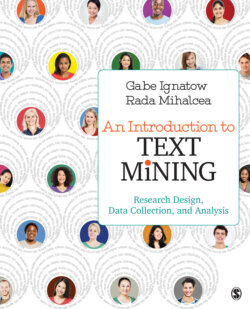Читать книгу An Introduction to Text Mining - Gabe Ignatow - Страница 16
На сайте Литреса книга снята с продажи.
Analysis of Discourse Positions
ОглавлениеAnalyzing discourse positions is an approach to text analysis that allows researchers to reconstruct communicative interactions through which texts are produced and in this way gain a better understanding of their meaning from their author’s viewpoint. Discourse positions are understood as typical discursive roles that people adopt in their everyday communication practices, and the analysis of discourse positions is a way of linking texts to the social spaces in which they have emerged. An example of contemporary discourse position research is Bamberg’s (2004) study of the “small stories” told by adolescents and postadolescents about their identities. Bamberg’s 2004 study is informed by theories of human development and of narrative (see Chapter 10). His texts are excerpts of transcriptions from a group discussion among five 15-year-old boys telling a story about a female student they all know. The group discussion was conducted in the presence of an adult moderator, but the data were collected as part of a larger project in which Bamberg and his colleagues collected journal entries and transcribed oral accounts from 10-, 12-, and 15-year-old boys in one-on-one interviews and group discussions. Although the interviews and groups discussions were open-ended, they all focused on the same list of topics, including friends and friendships, girls, the boys’ feelings and sense of self, and their ideas about adulthood and future orientation. Bamberg and his team analyzed the transcripts line by line, coding instances of the boys positioning themselves relative to each other and to characters in their stories.
Edley and Wetherell’s (1997, 2001; Wetherell & Edley, 1999) studies of masculine identity formation are similar to Bamberg’s study in that they also focus on stories people tell themselves and others in ordinary everyday conversations. Edley and Wetherell studied a corpus of men’s talk on feminism and feminists to identify patterns and regularities in their accounts of feminism and in the organization of their rhetoric. Their samples of men included a sample of white, middle-class 17- to 18-year-old school students and a sample of 60 interviews with a more diverse sample of older men aged 20 to 64. The researchers identified two “interpretative repertoires of feminism and feminists,” which set up a “Jekyll and Hyde” binary and “positioned feminism along with feminists very differently as reasonable versus extreme” (Edley & Wetherell, 2001, p. 439).
In the end, analysis of discourse positions is for the most part a qualitative approach to text analysis that relies almost entirely on human interpretation of texts (see Hewson, 2014). Appendix D includes a list of contemporary qualitative data analysis software (QDAS) packages that can be used to organize and code the kinds of text corpora analyzed by Bamberg, Edley, Wetherell, and other researchers working in this tradition.
